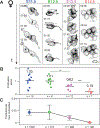A tug-of-war between germ cell motility and intercellular bridges controls germline cyst formation in mice
- PMID: 39566500
- PMCID: PMC11652221
- DOI: 10.1016/j.cub.2024.10.062
A tug-of-war between germ cell motility and intercellular bridges controls germline cyst formation in mice
Abstract
Gametes in many species develop in cysts-clusters of germ cells formed by incomplete cytokinesis-that remain connected through intercellular bridges (ICBs). These connections enable sharing of cytoplasmic components between germ cells and, in the female germ line, enrich select cells in the cyst to become the oocyte(s). In mice, germline cysts of variable sizes are generated during embryonic development, thought to result from cyst fractures. Studies of fixed samples failed to capture fracture events, and thus, the mechanism remained elusive. Here, we use high-resolution live imaging of germ cells within their native tissue environment to visualize germline cyst dynamics. With this novel approach, we reveal a striking motile phenotype of gonad-resident germ cells and show that this randomly oriented cell-autonomous motile behavior during cyst formation underlies fracture events. Conversely, we show that stabilized ICBs help resist excessive fracturing. Additionally, we find that motility and thus fracture rates gradually decrease during development in a sex-dependent manner, completely ceasing by the end of cyst-forming divisions. These results lead to a model where the opposing activities of developmentally regulated cell motility and stable ICBs give rise to cysts of variable sizes. We corroborate these results by developing a model that uses experimentally measured fracture rates to simulate cyst formation and fracture and show that it can reproduce experimentally measured cyst sizes in both male and female. Understanding how variable cysts form will enable further studies of mammalian oocyte selection and establishment of the ovarian reserve.
Keywords: Oogonia; cell motility; cyst; cytokinesis; germline; intercellular bridge; live imaging; mouse; ovary.
Copyright © 2024 Elsevier Inc. All rights reserved.
Conflict of interest statement
Declaration of interests The authors declare no competing interests.
Figures






References
MeSH terms
Grants and funding
LinkOut - more resources
Full Text Sources
Molecular Biology Databases

